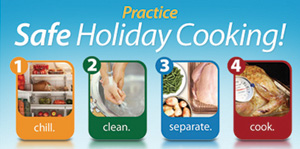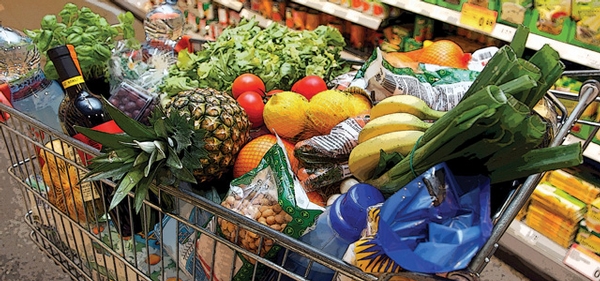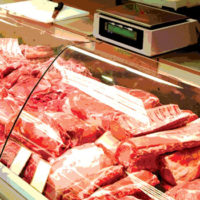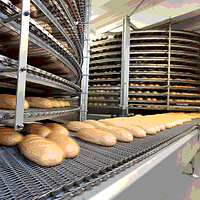Editor’s Note: While every player in the flow of food from farm to table has some degree of responsibility for food safety, retailers and foodservice operators are usually the last line of defense before food reaches the consumer.
As such, they have a significant share of the responsibility for ensuring food safety. By voluntarily developing a food safety management system, both retail and foodservice establishments can better ensure that the foods served or sold in their businesses are safe.
Unlike many food processing operations, the retail and foodservice industries are not easily defined by specific commodities or conditions. These establishments generally have a wide range of employee resources, from highly trained executive chefs to entry-level, front-line employees representing a broad spectrum of education levels and communication skills. Many are start-up businesses operating without the benefit of a large corporate support structure. Having a relatively low profit margin means they may have less money to work with than other segments of the food industry. The number and variety of production techniques, products, menu items and ingredients used are vast. Suppliers, ingredients, menu items and specifications may change frequently.
Given the increased number of recalls over the past several years and the attention paid to revamping the regulations affecting the world’s food supply, this article discusses what both retail and foodservice establishments are doing to provide safe food to their consumers. However, the complexity of modern food production and distribution networks—including the fact that many ingredients are coming from various parts of the world—makes ensuring food safety in these operations exceptionally challenging. —B.V.
In response to the spate of foodborne illness outbreaks and related product recalls during the past few years, retail and foodservice companies are taking greater care in selecting business partners that will be proactive in food safety. Retailers and foodservice operators are demanding that the processors and distributors they work with have quality systems in place that include the following essential components:[1]
• Good food handling practices
• Proper personnel training (Good Manufacturing Practices)
• Effective pest control program
• Good cleaning and sanitation practices
• Proactive shipping and receiving programs
• Traceability and recall programs
• Hazard Analysis and Critical Control Points (HACCP) Program
• Food allergen segregation and labeling (for processors)
• Food defense program
Certification Programs[2]
Beyond the essential components listed above, more retailers and foodservice operators are now asking their suppliers and distributors to have certifications [e.g., Safe Quality Food (SQF), British Retail Consortium (BRC) or ISO 22000/PAS220] that demonstrate their compliance with food safety regulations in both domestic and global markets, at all stages of the supply chain. Both SQF and BRC Certification Programs are recognized by the Global Food Safety Initiative (GFSI). BRC was developed in response to retailer demand with contributions from retail, manufacturing, industry associations and certifying bodies.[3] It requires full commitment to the implementation of the Global Standard for Food Safety to the senior management. SQF is designed as a food safety program, but it also covers product quality. ISO 22000 is a globally accepted, food safety management system that focuses on ensuring that foods in the food chain do not cause adverse effects.
Facility Audits
With lessons learned from the Peanut Corporation of America (PCA) Salmonella outbreak that sickened 700 people and was blamed for at least nine deaths, more retailers and foodservice operators are conducting their own facility inspections, either using a third-party organization or their own internal Quality Assurance personnel.[4] When it comes to food safety, we can trust our business partners, but we should verify the information they provide. Trust is an important foundation of the food supply chain, and it is imperative to preserve it.[5]
Performing an unannounced facility inspection to see the real-world operations on a daily basis is becoming a common practice. However, this raises the risk that important documents needed in the audit, such as personnel records, may not be available if the person in charge is off site. If the supplier/processor is committed to food safety, a contingency plan to address unscheduled inspections must be in place.[6]
The numerous foodborne illness outbreaks that have occurred in the past few years have resulted in diverse, independent initiatives from the retail and foodservice segments to identify best practices and establish new standards and verification programs in the fresh produce industry.[7] Some of these initiatives include: irrigation-water standards, establishing distance from domestic animals, corrections for incursions by wild animals, soil factor analysis, increased emphasis on the hygienic practices of workers and microbial testing both pre- and post-harvest. Retail and foodservice operators are continuously demanding more stringent adherence to Good Agricultural Practices from their suppliers.
Transport and Cold-chain Monitoring
Transport of both ingredients and finished goods is one of the most overlooked, neglected areas in supply chain. More and more retail and foodservice operators are realizing the critical role of distributors in the supply chain. No matter how high the level of integrity of the finished product leaving the manufacturing plant, if the product is not stored in the warehouse and transported in the truck at the correct temperature, its safety will be compromised.[1,8] Many foodservice operators are now performing delivery process audits to gain confidence that the goods arriving at their establishments have been handled safely and meet their specifications. The sanitary conditions of the delivery trucks, zone temperatures, handling practices to prevent cross-contamination and security practices are all major concerns during shipping.
Any time perishables are handled, there are shelf-life and safety issues involved. Maintaining proper temperatures during shipment from suppliers to distributors to restaurants and retail stores is critical to preserving product integrity and safety. Pre-cooling the trailer is extremely important when loading perishables such as produce. For every 10 °C (18 °F) above optimum temperature, the rate of deterioration increases two to three times. As fuel costs continue to increase, more distributors may try to cut corners. Through cold-chain monitoring, retail and foodservice operators can stay in compliance with HACCP. The system continuously monitors the temperature of the products at set intervals and reports are generated for record keeping and audit support.
Imported Products
Given current economic conditions, many foodservice operators are sourcing commodities at the lowest possible prices to help with food costs, which have a significant impact on a restaurant’s bottom line. According to the U.S. Department of Agriculture’s Economic Research Service, approximately 15% (by volume) of the overall U.S. food supply is imported.[9] About 60% of fresh fruits and vegetables consumed in the U.S. are imported. Imported seafood has risen from less than 50% of U.S. seafood consumption in 1980 to more than 75% today. While many countries have well-developed regulatory systems to ensure food safety, other systems are less sophisticated and may compromise food safety.
Product Testing
In the July 2009 edition of Seafood Business, the associate editor stated that the U.S. Food and Drug Administration (FDA) will not increase import inspections, so it’s up to the industry to start policing its own—a tall order for an industry rife with fraud.[10]
From 2002 to 2006, the FDA repeatedly found antimicrobial agents in various seafood products that are not approved in the U.S., including chloramphenicol, nitrofuran, malachite green, gentian violet and fluoroquinolones. Chloramphenicol can cause aplastic anemia and is a potential carcinogen. Nitrofuran, malachite green and gentian violet have been shown to be carcinogenic with long-term exposure in lab animals. The use of fluoroquinolones in food animals may increase antibiotic resistance to this important class of antibiotics.
In 2007, the FDA discovered that Chinese wheat flour contaminated with melamine, a chemical in plastics and pesticides, ended up in some U.S. aquaculture operations.[11] Chinese processors had used melamine and other compounds to falsely increase the protein profile of the flour, which had also been found in hog and poultry feed and in pet food. The FDA ended up issuing an import alert for several feed and food products found to be contaminated with melamine and melamine-related compounds.
As a result of such incidents, some retailers and foodservice operators have expanded their food safety programs to require testing of imported products that have been associated with chemical adulteration.[12] In some cases, foodservice companies have established their own facilities in other countries, so that their own Quality Assurance personnel can conduct testing to verify product safety and wholesomeness.
Educating and Training Personnel
The National Restaurant Association (NRA) estimates that in spite of the most challenging economic conditions in nearly three decades, the restaurant industry experienced growth in 2009.[13] Total restaurant industry sales were forecasted to be nearly $566 billion, an increase of 2.5% over 2008’s returns, and equal to 4% of the U.S. gross domestic product. Additionally, although consumers have expressed serious concerns about their finances, they strongly believe that restaurants are an essential part of their lifestyle. Clearly, Americans will continue to eat many of their meals outside the home.
At the same time, public concern about foodborne illness and demand for more vigorous prevention of outbreaks continues to grow. These parallel trends make clear the importance of food safety education and training for foodservice personnel.
The top five risk factors for foodborne illness in foodservice operations include:
• improper holding temperatures
• inadequate cooking
• contaminated equipment
• purchase and receipt of food from unsafe sources, and
• poor personal hygiene.[14]
According to the CDC, norovirus and Salmonella were the leading causes of foodborne illness outbreaks in 2006.[15] Norovirus outbreaks are usually associated with poor personnel hygiene, such as improper washing of hands after using the bathroom. Salmonella outbreaks are usually caused by cross-contamination or improper cooking. Most such outbreaks are preventable, through proper education and training of employees. Training may originate from internal or external sources, or both.
Recently, more restaurant operators have been sending their managers and employees for training and certification in food safety. ServSafe, a comprehensive food safety education and training program developed by the NRA Education Foundation and widely recognized by many state and local jurisdictions, is one of the most popular programs. The NRA is also developing educational partnerships with various health, environmental and consumer organizations, as well as state and local health officials.
The publication of the FDA Food Code, which serves as the foundation of the FDA’s National Retail Food Program, has assisted retailers and foodservice operators tremendously. The Food Code represents FDA policies and the best science-based advice for a uniform system of food safety provisions in retail and foodservice establishments.[16] The Food Code not only enhances food safety practices based on scientific information but also provides valuable resources for developing a food defense program.[17] Many states revise and update their own codes after the FDA publishes a new Model Food Code.
Two successful programs at H-E-B and The Kroger Company (see Catch the Wave of Food Safety, and Branding Your Food Safety Message) are provided to illustrate the innovative solutions at work in the retail segment.
Safety Cannot Be Ignored
Even with the economic downturn, most retailers’ and foodservice operators’ awareness of and attention to food safety has continued to grow. There has been enough media coverage on notable foodborne illness outbreaks—and the resultant recalls and other negative outcomes—that the issue of food safety is difficult to ignore. Food establishments know that cutting corners on food safety may result in devastating economic consequences and irreparable harm to their business.
Food safety trends in both retail and foodservice will continue to be influenced by consumer behaviors. Successfully meeting consumer demand for safe and wholesome foods requires consistent and concerted effort from every link in the supply chain and from all levels of your organization.
Veny Gapud, M.S., is the former Director of Quality Assurance and Food Safety for Popeyes Louisiana Kitchen. She is the chairperson of the Retail Food Safety & Quality Professional Development Group of the International Association for Food Protection (IAFP), president of the Georgia Association for Food Protection, and a member of the Food Safety Magazine Editorial Advisory Board. She holds master’s degrees in Chemistry and in Food Science. Gapud can be reached at veny525@aol.com.
References
1. Gapud, V. 2006. Driving Best Practices in Distribution. Food Safety Magazine. August/ September.
2. Surak, J. G. and Gombas, K.L. 2009. GFSI’s Role in Harmonizing Food Safety Standards. Food Safety Magazine. June/July.
3. Eagle Registrations Inc. 2009. Food Safety Standards...The Basics 101.
4. www.cbc.ca/consumer/story/2009/03/20/salmonella-peanuts.html.
5. www.accountability-central.com/hot-topics/hot-topic-focus-on-food-safety.
6. Stier, R. F. 2009. Third-party Audits: What the Food Industry Really Needs. Food Safety Magazine. October/November.
7. Gombas, D. E. 2008. Food Safety Policy State of the Industry. United Fresh Produce Association.
8. Hernandez, J. A. 2009. Foodservice Distribution: Maintaining the Cold Chain. Food Safety Magazine. August/September.
9. www.fda.gov/downloads/About FDA/CentersOffices/OC/OfficeofOperations/UCM121761.
10. Seafood Business, July 2009 28:7. Editor’s note.
11. www.foodandwaterwatch.org/fish/seafood/melamine-fishfeed.
12. Heller, D. N. and Nochetto, C. B. 2009. LC/MS Analysis for Melamine and Cyanuric Acid in Foodstuffs. Food Safety Magazine. February/March.
13. National Restaurant Association. 2009 Restaurant Industry Forecast.
14. Roberts, K.R., Barrett, B.B., Howells, A.D., Shanklin, C.W., Pilling, V.K. and Brannon, L.A. 2008. Food Safety Training and Foodservice Employees’ Knowledge and Behavior. Food Protection Trends. 28:252-260.
15. www.cdc.gov/media/pressrel/2009/r090611.htm.
16. www.healthypeople.gov/data/midcourse/html/focusareas/FA10Opportunities.htm.
17. www.fda.gov/NewsEvents/Speeches/ucm052331.htm.
SideBar
Catch the Wave of Food Safety
As the food industry continues to evolve, so do consumer knowledge and expectations around food safety. Safe, fresh food is a top priority for the retail grocery industry and with ever-changing business opportunities, maintaining food safety can be a challenge at the store level.
The retail grocery business has evolved over the past 100 years from offering simple, mostly non-perishable items to housing complicated and innovative foodservice operations. Bake, cook and prepare-from-scratch operations are becoming more commonplace at the grocery store and have enhanced the offerings to the customer significantly. With that said, these increasingly complex and intricate processes provide an additional challenge for front-line workers with regard to best practices and safe food handling. Top retailers like H-E-B are always looking for ways to continually improve food safety execution at store level. Four basic pillars that can assist in food safety maintenance include: commitment, training, tools for success and accountability.
Commitment comes from the top down and must be a part of the culture of a company. This commitment to food safety must be felt at all levels of the organization and be made a part of the day-to-day life of the business. Open communication between the appropriate stakeholders is necessary as is the frequent sharing of ideas and ways to improve. Utilizing top leadership to spread the message through electronic means, videos, pamphlets and training modules helps to bring all employees together in a unified commitment to food safety and execution.
Training is imperative and must be integrated into the daily running of the business. Customized courses for Certified Food Managers, department employees, receivers and front-end workers must be in place. Don’t forget to educate your leadership. The merchant teams are the thought leaders and the experts. Regularly educating them on food science and technology related to their areas of expertise is a sure win. Always look for the next training opportunity to include maximizing how you utilize your vendors in this objective.
Tools for success are the fun part! How do you provide the right tools to give all employees the best chance at successfully executing the delivery of a safe, fresh product? Branding your messages is one idea that has worked at H-E-B. Our Partners “Catch the Wave of Food Safety” by physically doing the “Wave” at meetings, gatherings, conferences and shows. It makes the presentation on food safety a memorable one. Many topics around the business are covered daily with employees, so branding the message helps to keep food safety top of mind.
At the store level, we give our Partners a variety of tools to help them successfully execute safe food practices every day. One of these tools is a “Stop & Go” program that engages the Partners of all fresh departments in a three-times-per-day check for food safety best practices and execution. A red light means that something needs to be addressed; a green light means all is a go!
Lastly, holding everyone accountable is a must. This can be challenging regarding how to follow through while maintaining a positive program. Each company will be different in how it structures rewards and consequences, but finding what works for your employees is the key. In our company, every Partner counts, and every Partner understands their responsibility around providing safe, fresh food for our customers. That is what it is all about—the customer, which includes our Partners’ families, children, grandparents and neighbors.
Quality Assurance is not always the most glamorous arena. Pest control, chemical programs and sanitation can provide challenges. Try to make it fun; make it powerful and make it important. Communicate, communicate, communicate. If you speak with passion, your employees will hear. Partnerships are key and at the end of the day, the result will be providing the safest, freshest products to those who trust you.
—Sharon Wood is the director of Food Safety at H-E-B, San Antonio, TX.
SideBar
Branding Your Food Safety Message
Most of us in the food safety field are proud to be right-brained, analytical, logical thinkers. We spend time developing policies and procedures designed to keep the foods our companies produce wholesome and safe for our customers. We typically leave branding up to our merchandising/marketing colleagues. But we know that our message is important and one that our associates and customers need and want to hear. So how can you brand your food safety message?
Branding is about getting your audience to see you as the only one that provides a solution to their problem. So let’s begin. There are four key elements to consider when branding a food safety message. Keep the message simple, clear, concise and positive. We see these key elements implemented, for example, in the new “be food safe” campaign (www.befoodsafe.org) introduced last year by the Partnership for Food Safety Education. The message is simple, “Be food safe. Clean. Separate. Cook. Chill.” I believe that this message—developed for consumers—is also a great message for our employees.
The key elements sound simple, but for scientists, communicating can be a difficult task. As we tend to get all wrapped up in the details and precision of our message, we lose our audience after one slip of a pathogen’s name. It is as if we are speaking a foreign language.
When branding your message, use creative communication to achieve the following five objectives:
• Deliver the message clearly. Simply translate your message to a 6th- to 9th-grade literacy level. Think of it this way. USA Today is written at the 9th-grade literacy level. Your message should be able to be used as a headline for USA Today, not The New York Times.
• Confirm your credibility. You are the food safety expert. That is why you were hired for your position.
 • Connect your target audience emotionally. Start with the heart. President Obama’s response to the PCA recall was a personal statement of concern for his daughter Sasha’s health since she eats peanut butter sandwiches frequently. Americans can relate to the worries that parents have over their children’s health and safety. He connected emotionally with his audience.
• Connect your target audience emotionally. Start with the heart. President Obama’s response to the PCA recall was a personal statement of concern for his daughter Sasha’s health since she eats peanut butter sandwiches frequently. Americans can relate to the worries that parents have over their children’s health and safety. He connected emotionally with his audience.
• Motivate buy-in. Buy-in has to start from the executive and filter down through all levels of your organization.
• Create loyalty. Companies that teach food safety to their associates and customers build good will and trust that results in loyalty to the brand.
Your food safety message must reside in the hearts and minds of your customers and associates. It is the sum total of their experiences and perceptions, some of which you can influence and some of which you cannot. To change behavior, you must start with the heart. People must believe before they can achieve. Does your food safety message motivate change?
As you begin branding your food safety message, you should also brand yourself. Personal branding can single you out as an expert in your field. Actually, personal branding is easier than company branding. If you believe in your talent, skills and abilities, it is easier to sell what you believe in; you just have to market it.
Establish yourself as the food safety expert to your associates and your customers. Partner with your communications team to write food safety columns in local newspapers and your company Web site, and appear on local news stations giving food safety demonstrations in the kitchen. Become a real “everyday” person who gives great practical advice that anyone can follow at home.
Brand yourself to your associates. Write simple, practical articles in company newsletters. Discuss food safety in video/satellite messaging, or give food safety demonstrations at union meetings. As associates at all levels of your organization begin to see your name and become aware of the benefits and knowledge that you offer, they will begin to seek out your services and expertise. They will identify you with your brand, which is you.
The secret is that branding your food safety message starts from the inside out. Do your employees believe in food safety? Are they standing behind you 100%? Are they living food safety at home, work and play? It is important that your employees are informed and involved in building a food safety culture. If they do not support your initiatives or projects, it will be extremely difficult to achieve success.
As you establish internal food safety message branding, use these three steps:
Step 1: Synchronize your brand, personality and message with corporate values and culture.
Step 2: Get your employees behind your brand.
Step 3: Reinforce and repeatedly explain your brand values and behaviors.
Always remember how important it is to involve your staff in the branding process, as they are the ones who meet, greet and assist your customers in many different ways. They are the face of your food safety message. Engage your staff right from the start and encourage individual input. Use your staff as a focus group—who knows your customers better than they do?
Every food safety professional’s goal is to provide wholesome and safe food for our customers, but branding yourself and your food safety message can sometimes seem self-serving. To add validity to your food safety message, consider a branding partner that the public trusts. You increase the strength of your food safety message when you partner with local colleges, universities, consumer advocacy groups, nonprofit organizations and local health departments. Get them actively involved in communicating the food safety message to your customers and associates.
Put these simple tips in place and you are on your way to building a community that believes and practices food safety at home, work and play.
–Gina R. Nicholson, RS, is a registered sanitarian and the food safety manager at The Kroger Company’s Columbus Division.




